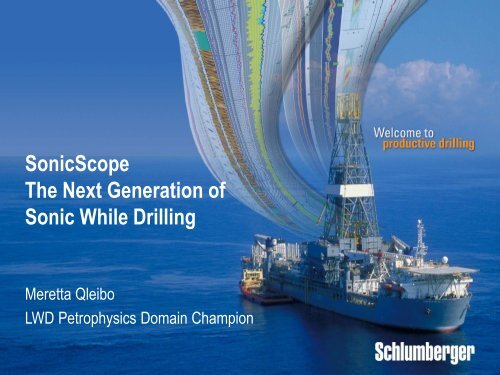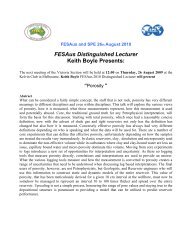SonicScope The Next Generation of Sonic While Drilling - FESAus
SonicScope The Next Generation of Sonic While Drilling - FESAus
SonicScope The Next Generation of Sonic While Drilling - FESAus
Create successful ePaper yourself
Turn your PDF publications into a flip-book with our unique Google optimized e-Paper software.
<strong><strong>Sonic</strong>Scope</strong><br />
<strong>The</strong> <strong>Next</strong> <strong>Generation</strong> <strong>of</strong><br />
<strong>Sonic</strong> <strong>While</strong> <strong>Drilling</strong><br />
Meretta Qleibo<br />
LWD Petrophysics Domain Champion
Agenda<br />
─Quadrupole: Why and How<br />
─Introduction to <strong>Sonic</strong> Scope<br />
─Local Example<br />
─Summary<br />
2
Why Multipole Why <strong><strong>Sonic</strong>Scope</strong><br />
─ Goal<br />
• Provide high data quality in real time<br />
• Deliver a robust compressional and shear measurement for all<br />
formations, irrespective <strong>of</strong> mud type<br />
─ Obtaining reliable compressional and shear provides<br />
• Pore pressure trends<br />
• Borehole stability analysis<br />
• Gas detection/saturation<br />
• Advanced drilling optimization/fracture gradient<br />
• Advanced formation evaluation<br />
3
From Monopole to Multipole<br />
2008<br />
onwards<br />
<strong><strong>Sonic</strong>Scope</strong><br />
• Multipole tool<br />
• Vp & Vs in all formations<br />
• Enhanced real-time delivery<br />
• Stoneley<br />
2004-<br />
2008<br />
sonicVISION<br />
• Monopole tool<br />
• Enhanced real-time delivery<br />
• Vp & Vs in “fast” formations<br />
1996<br />
iSONIC<br />
• First LWD sonic tool<br />
• Monopole tool<br />
• Vp only<br />
4
Review <strong>of</strong> Borehole Acoustic Modes<br />
Monopole<br />
Dipole<br />
Quadrupole<br />
5
Dispersive Waves, Flexural and Quadrupole Modes<br />
─ Slowness <strong>of</strong> the wave varies with frequency<br />
Dipole flexural<br />
Quadrupole<br />
Stoneley wave<br />
Dipole flexural<br />
wave<br />
Quadrupole wave<br />
6
Why Quadrupole and Not Dipoles for LWD<br />
Wireline dipole<br />
Wireline tool<br />
Drill Collar<br />
LWD quadrupole<br />
dipole<br />
Slowness<br />
Wireline<br />
tool flexural<br />
No interference<br />
Borehole flexural<br />
Formation shear<br />
Fast collar<br />
flexural mode<br />
Slowness<br />
Borehole<br />
quadrupole<br />
Strong<br />
Coupling<br />
Collar quadrupole<br />
Collar<br />
flexural<br />
Frequency<br />
Borehole<br />
flexural mode<br />
Frequency<br />
7
<strong><strong>Sonic</strong>Scope</strong> 825 – Key Technologies<br />
Dual Layer Quadrupole Transmitter<br />
• High power to excite Quadrupole in slow formations<br />
• Situated close to the receiver section to overcome attenuation<br />
“G42” Receiver Belts<br />
• 12 levels spaced at 90 degrees, 48 receivers total<br />
• Industry best 4” inter-receiver spacing, aliasing completely eliminated<br />
• Signal digitized at the receiver enables faster downhole processing<br />
• 4 bulkheads vs. 28 for QBAT = stronger collar, simpler acoustic modeling<br />
Screw on Centralizers<br />
Optimized Attenuation Section<br />
• Ensure mode purity<br />
• Wellsite Changeable<br />
• Hard Faced<br />
• Monopole collar arrival suppressed as low as possible<br />
• I.D. optimized to separate QP propagation modes<br />
• Enables Automatic Labeling, STC threshold<br />
8
Quadrupole Shear Inversion<br />
─ Model-Based Inversion<br />
• Dispersive approach<br />
• Account for tool presence effect<br />
─ Tool Presence<br />
• Tool equivalent model<br />
• Includes all tool details<br />
─ Quadrupole Inversion Methodology<br />
• Homogeneous Isotropic model<br />
• Tool equivalent model<br />
• Maximizing the semblance<br />
Slowness (us/ft)<br />
Slowness (us/ft)<br />
Modeled Quadrupole Mode<br />
Borehole <br />
quadrupole mode<br />
Mode Search<br />
RZX Modeling<br />
Note: Size <strong>of</strong> the dots indicate energy<br />
Frequency (kHz)<br />
Shear value<br />
Real Quadrupole Data<br />
Measured Data<br />
Model HI<br />
Shear value<br />
Frequency (kHz)<br />
9
Local Data Review – <strong><strong>Sonic</strong>Scope</strong>825<br />
• North West Shelf well<br />
• 12 ¼” hole section, near vertical<br />
• Fast and slow formations<br />
• Wireline logging suite included <strong>Sonic</strong> Scanner<br />
10
Real Time Operations<br />
DTCO, DTSM<br />
(RT)<br />
40 us/ft 240<br />
• Compressional delivered in real time<br />
P<br />
P<br />
S<br />
• Coherency plot and pumps <strong>of</strong>f transmitted to<br />
enable QC <strong>of</strong> the data<br />
• Pumps <strong>of</strong>f test performed every stand<br />
• Real time applications include seismic tie ins,<br />
pore pressure modeling and geomechanics<br />
11
Data analysis <strong>of</strong> high-frequency monopole<br />
P<br />
S<br />
Stoneley<br />
Fast<br />
Formation<br />
P S St<br />
St<br />
S<br />
P<br />
Slow<br />
Formation<br />
P<br />
St<br />
St<br />
P<br />
12
Data analysis <strong>of</strong> high-frequency monopole<br />
Fast<br />
Formation<br />
P S St<br />
St<br />
St<br />
S<br />
S<br />
P<br />
P<br />
S<br />
Slow<br />
Formation<br />
P<br />
St<br />
St<br />
St<br />
P<br />
P<br />
P<br />
13
Shear from Quadrupole Inversion<br />
Homogeneous Isotropic<br />
Quadrupole dispersion curve<br />
Shear slowness<br />
14
<strong>Sonic</strong> Scanner Comparison<br />
Fast Formation, Monopole<br />
LWD<br />
(RT)<br />
LWD<br />
(REC)<br />
WL<br />
• Comparison between <strong><strong>Sonic</strong>Scope</strong> Real<br />
time, memory data, and <strong>Sonic</strong> Scanner<br />
log (Monopole only)<br />
• Memory data from <strong><strong>Sonic</strong>Scope</strong> and <strong>Sonic</strong><br />
Scanner show excellent agreement<br />
• Real Time data quality is as good as<br />
memory mode data<br />
• Shear data is available in Real Time from<br />
Monopole only (fast formations)<br />
15
<strong>Sonic</strong> Scanner Comparison<br />
Slow Formation, Monopole<br />
LWD<br />
(RT)<br />
LWD<br />
(REC)<br />
WL<br />
• Comparison between <strong><strong>Sonic</strong>Scope</strong> 825<br />
Real time, memory data, and <strong>Sonic</strong><br />
Scanner log (Monopole only)<br />
• Monopole data in slow formation will not give<br />
shear if Shear DT > Mud DT<br />
• Compressional from Monopole approaching<br />
mud DT requires Leaky-P processing<br />
16
<strong>Sonic</strong> Scanner Comparison<br />
Slow Formation, Quadrupole<br />
LWD<br />
Quadrupole<br />
WL Dipole<br />
• <strong><strong>Sonic</strong>Scope</strong> Quadrupole shear shows an<br />
excellent match to <strong>Sonic</strong> Scanner Dipole<br />
shear<br />
• Shear DT acquired up to 540 us/ft<br />
17
Summary<br />
• <strong>Sonic</strong> Scope service is now available in 4.75” and<br />
8.25” collars<br />
• Robust compressional delivered to client in real time<br />
• High quality waveforms enable data analysis and QC<br />
• Excellent Agreement between <strong><strong>Sonic</strong>Scope</strong> and<br />
Wireline <strong>Sonic</strong> Scanner<br />
18
<strong><strong>Sonic</strong>Scope</strong><br />
─ Latest Schlumberger <strong>Generation</strong> <strong>of</strong> Real-Time LWD <strong>Sonic</strong><br />
─ High Quality Monopole Data<br />
─ Multipole Capability<br />
─ Available in 4.75” and 8.25” collars<br />
19




